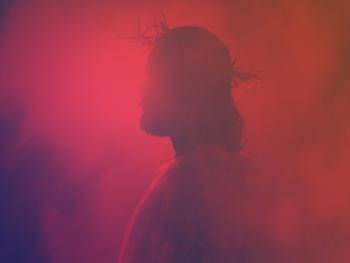
Religious films are fairly common and surprisingly popular, even today. And religion often influences the storyline of movies that are not overtly religious. For example, the 1993 Bill Murray movie, “Groundhog Day,” clearly has very strong Buddhist undertones. And the wildly popular 2009 film, “Avatar,” has Hindu teachings and symbols imbedded in its storyline and scenes.
In addition to religious themes in movies, sacred scripture is sometimes adapted for the “big screen.” For example, Cecil B. DeMille’s 1956 classic, “The Ten Commandments,” draws its plot from the Jewish and Christian scriptural canons, as does the 2014 Russell Crowe movie, Noah. The “Veggie Tales” franchise has famously popularized the stories of the Bible by telling them in cartoon format. And, in 2000, DreamWorks produced the animated “Joseph: King of Dreams,” also based on the biblical text.
Perhaps more than any other religion, Hindu teachings and scriptures have made their way into popular cinema. Hindu holy texts are constantly being made into Bollywood blockbusters, mostly geared toward adults, but some for Children as well.
One of the benefits of using film to depict the most famous or important passages of scripture is found in the fact that sacred texts are often dense and difficult for outsiders to understand or learn. The language, narratives, terminology and even theology are often beyond the grasp of those of a different religious tradition. Hence, when a scriptural text is dramatized in the film, that often makes the holy book accessible to and even meaningful to larger groups of people—both inside and outside of the tradition to which those scriptural texts belong.
The Church of Jesus Christ of Latter-day Saints (or “Mormon” Church) has long been in the “movie business,” producing films to inspire and educate their members, as well as ones to explain the faith to those who aren’t members. Outside of the “officially” produced films, independent LDS filmmakers have created their own entertaining and inspiring films. Even LDS cartoons have been part of the “Mormon Movie market.”
In perhaps their most ambitious project yet, on June 9th, 2022, the Communications Department of The Church of Jesus Christ of Latter-day Saints announced the filming of the fifth and final season of Book of Mormon videos. This project has taken the most significant narratives of the Book of Mormon and depicted them in a cinematic fashion. The quality of production rivals anything from Hollywood, according to Elder Michael A. Dunn, whose entire professional career was in broadcasting and film production. Dunn noted:
“I’ve worked on a lot of high-end productions in my career, and nothing has equaled this in terms of attention to detail. Is this costume right? Do you think that’s authentic? Let’s check with the historians. What did the Book of Mormon say about the size and stature of this character? And so on. I’ve really appreciated the sort of accuracy and attention to detail—ten times better than what I’ve been accustomed to, and I’ve worked in Hollywood. This is top of the line.”
Thus, like Hinduism’s Bollywood productions of scripture stories, the five seasons of the Book of Mormon videos have a quality that would be hard to surpass. And yet, “To say that these are intended as pure entertainment would be a great misnomer,” Elder Ronald A. Rasband (of the Church’s Quorum of the Twelve Apostles) told me. These videos have a higher purpose. They are “focused on the words of scripture itself,” notes Rasband. And the makers of these videos see that as a sacred trust. As Michael Dunn noted, “the stakes are a lot higher here” than when working on a Hollywood movie. Because it is sacred scripture (for members of The Church of Jesus Christ of Latter-day Saints), “‘good enough’ isn’t going to cut it. It has to be accurate.”
The purpose of this series is to help those unfamiliar with the Book of Mormon, its history and background, to better grasp what the book is and what it contains. Bill Elliot, a media director for the Church—and an executive producer on this series—noted that “these videos were never meant to replace the scriptures. They’re really just a springboard to understanding and study of the scriptures. I always say,” Elliot adds, “if you like the videos, read the book. It’s much better!” Elder Kevin S. Hamilton, a General Authority Seventy of the Church, similarly noted, “the videos can provide additional context, background, time and setting” to the scriptures—for members of the Church, but also for those who are not Latter-day Saints.
Though approximately 200 million hard copies of the Book of Mormon have been printed and distributed in more than 115 languages, it nevertheless remains a book that most people have not read and that most people have misconceptions about. Thus, these videos have relevance to those who are not members of the LDS Church. Rob Jex, Secretary to the Scriptures Media Committee, told me:
“Friends of the Church would be interested in these videos because they depict the same Jesus as appears in the New Testament. But these videos focus on His post-resurrection ministry in the New World, rather than in the Old World (where the Bible takes place). The Book of Mormon is often seen as a book of scripture for Mormons. But we’re producing videos so that theses sacred stories can become familiar to everyone—because they’re relevant for everyone… One of the proposes [in producing these] is to introduce people to the characters of the Book of Mormon. Other than the Savior, most of the names and the stories will not be known to the average person… These will help people become familiar with the stories and their relevance to their lives.”
Kevin Hamilton, who is a member of the supervisory committee over the production of these videos explained, “we very much think about the general audience. How will people that know nothing about the Book of Mormon react when they see this? How will people who know nothing about the Savior react? What of people from a non-Christian background? We’re a global Church, we’re in every country. How do people navigate this that don’t have…a Christian foundation?” These are the kinds of things that are in the backs of the minds of the writers, producers, and directors, as they try to bring the Book of Mormon to life. “If we do nothing else,” Hamilton added, “but introduce [the Book of Mormon] …and kind start the creative juices flowing in people’s minds, I think that would be successful.”
Though certainly unknown by the majority of people, the Book of Mormon is said to be the “fourth most influential book in American literature.” Coming from a religion that Roman Catholic theologian Steven Webb described as “obsessed with Christ,” these five seasons of Book of Mormon videos make it possible for those who would likely never sit down and read the 531-page text cover-to-cover to get a taste of what that scriptural text contains, and how Christ-focused members of the LDS Church are.


